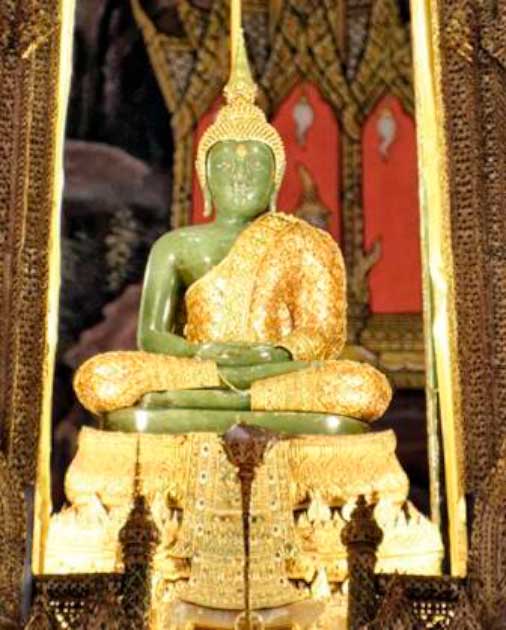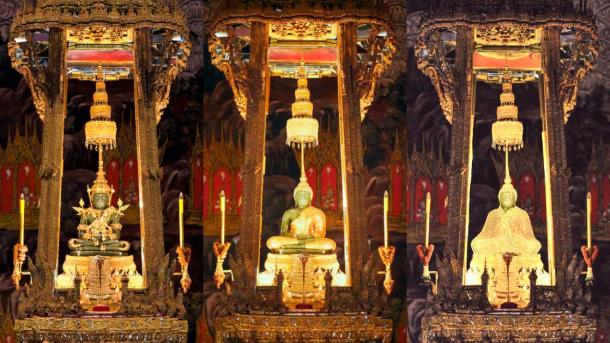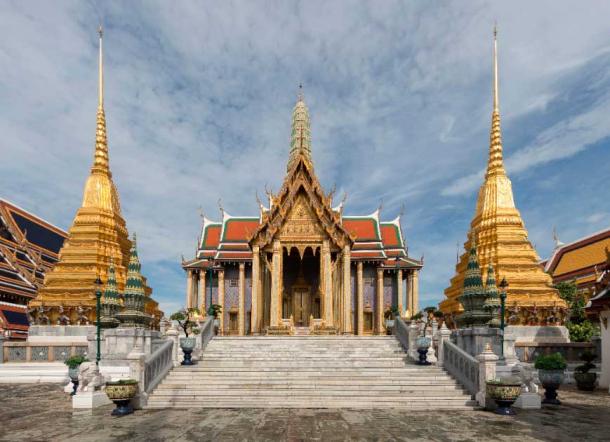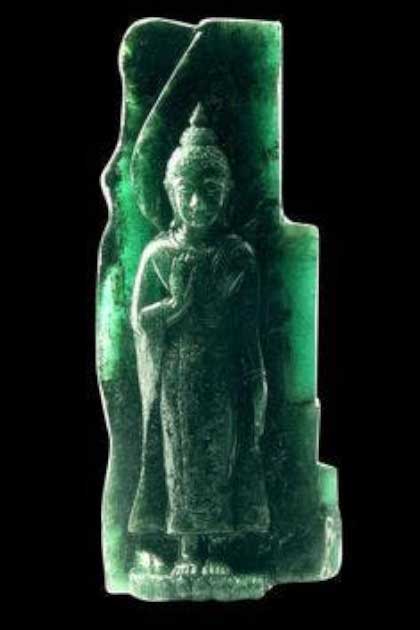
The Sacred Emerald Buddha: A Message of Peace
The religion of Buddhism has several sacred icons, but one of the most sacred is the famous Emerald Buddha. Housed in a temple named after it, the Emerald Buddha is an essential aspect of Buddhist culture and is known worldwide. Although its overall history is well-documented, its origins remain speculative.
In the early 2000s, a new Buddhist icon was born. Titled the Sacred Emerald Buddha, the 2,620-carat emerald sculpture was carved out of a rare emerald crystal sourced from Africa. Because of its rarity, a gem dealer who purchased the crystal decided to use it to create a symbol of peace. Now, the icon is housed in Thailand, also home to the original Emerald Buddha, and is known as one of the world’s largest known carved emeralds.
The Traveling Emerald Buddha: A Long History
The historic Emerald Buddha is housed in the Temple of the Emerald Buddha in Bangkok, Thailand. The statue is estimated to be from the 15th century and is carved from semi-precious green stone. Though the title of the sculpture is the Emerald Buddha, it is actually made from jasper, with gold elements. The statue is approximately 26 inches (66 centimeters) high and sits in the meditative posture central to Indian Buddhist worship.
- Scholars Get Closer to Words of Buddha as They Unravel Oldest Buddhist Scrolls in the World
- The Leshan Giant Buddha: Largest Stone Buddha in the World

A close-up of the historic Emerald Buddha (JPSwimmer / CC BY SA 3.0)
The origin of the Emerald Buddha stems from a legend titled The Chronicle of the Emerald Buddha by Brahmarājapañña. The legend was written in the 15th century and contains a combination of true stories and fictional tales. According to this source, the Emerald Buddha was created by Nagasena, a sage in ancient Patna, India in 43 BC. Nagasena was assisted by Vishnu and Indra, two famous Hindu deities, in making the Emerald Buddha.
After its creation, the Emerald Buddha remained in ancient Patna for several hundred years, but was later transported to Sri Lanka for safety reasons. In the centuries that followed, the Emerald Buddha was transported to many areas, including Ayutthaya and Chiang Rai in Thailand, as well as places in Cambodia and Laos. Its hiding place in northern Thailand was eventually found in 1434, supposedly after a lightning bolt struck the stupa where it was stored. The Emerald Buddha was covered in white stucco after years of hiding. After noticing some of it flake away, the local abbot removed the rest of the stucco and revealed the true statue. He then titled the sculpture the Emerald Buddha after its color, rather than its composition.
- Large, Rare Statue Portraying the Death of Buddha Unearthed at Ancient Bahmala Stupa Site
- The Legendary Emerald Tablet and its Secrets of the Universe

3 outfits of the historic Emerald Buddha, whose clothes are changed by the King of Thailand each season. (Sodacan / CC BY SA 4.0)
The Emerald Buddha continued to travel for several centuries after its rediscovery. It spent several years in Chiang Mai before relocating to Vientiane, Laos for another 214 years. After Vientiane was captured in 1779, the Emerald Buddha was taken to Siam until Bangkok became the capital of the Chakri Dynasty. Chao Phra Chakri, the head of the dynasty, built the Grand Palace in Bangkok and moved the Emerald Buddha there, where it has remained for over 200 years.

One of the most sacred Buddhist temples is Wat Phra Kaew, the Temple of Emerald Buddha, in Bangkok, Thailand (Basile Morin, CC BY-SA 4.0)
From Emerald Crystal to Symbol of Peace
In 1994, Thai gem dealers found themselves in a competition for a one-of-a-kind discovery. A 3,600-carat emerald crystal was discovered in Africa, although the exact location is disputed. Since natural emerald crystals of this size are quite rare, many gem dealers negotiated with the discoverers to become the crystal’s new owner. These negotiations took place in Thailand, where the emerald was transported after its discovery.
Because of its size, many gem dealers sought to band together and take pieces of the emerald for themselves. Before the emerald could be broken into pieces, one fascinated gem specialist, Jeffrey Bergman, shared his offer to purchase the entire crystal intact. After much negotiation, he purchased the crystal for himself and set out to turn it into a masterpiece.
Bergman did a lot of research before diving into the task of carving the emerald. Because of its long shape and destiny to remain in Thailand, he decided to have it carved into a Buddha standing in the Harm Yhard posture. This posture is known as a symbol to stop fighting between one another, especially among family members. Bergman hired a Myanmar jadeite Buddha carver named Aung Nyein to complete the task. At the time of his hiring, he had over twenty years of Buddha-carving experience under his belt.
Nyein was considered a master at his craft. He spent several weeks studying the gemstone and forming a plan to carve it into a beautiful standing Buddha statue. After several weeks of cutting, grinding, and sanding, the piece was finally completed in February 2006. After its completion, it was presented to the Gem and Jewelry Institute of Thailand (GIT) and the GemResearch Swisslab AG (GRS) for independent gemological laboratory certification.
In its final form, the Sacred Emerald Buddha statue is 2,260 carats of emerald crystal. It is a one-of-a-kind icon in Buddhism and is highly revered for its representation of peace and harmony.

The new Sacred Emerald Buddha was carved into a classic standing pose (Jeffrey Bergman)
A One-Of-A-Kind Masterpiece
The Sacred Emerald Buddha statue is considered one of the largest natural emerald crystal carvings in the world. On record, there is only one carved emerald larger than this, at a whopping 86,000 carats. However, some gem dealers say there should be a distinction between these carving types. The giant 86,000-carat emerald statue was carved from opaque emerald, while the Sacred Emerald Buddha was carved from high-quality gem-grade emerald. Given this comparison, the Sacred Emerald Buddha is certainly the largest carved emerald statue of such high quality.
It is unclear if the Sacred Emerald Buddha statue is currently on display to the public. It may be in a private collection with only photos shared for those interested in seeing the statue. However, you can visit the real Emerald Buddha in Wat Phra Kaew as long as a religious ceremony is not taking place. Many who have visited remark on the beauty of the statue in person and highly recommend visitors take the time to see it.
Top image: The historic Buddhist icon Emerald Buddha at Wat Phra Kaew temple. Source: JPSwimmer / CC BY-SA 3.0
By Lex Leigh
References
Bergman, J. July 7, 2021. The Sacred Emerald Buddha. International Gem Society. Available at: https://www.gemsociety.org/article/sacred-emerald-buddha
Larif, S. August 28, 2020. Sacred Emerald Buddha. Internet Stones. Available at: https://internetstones.com/sacred-emerald-buddha
Martins, K. May 21, 2020. The Temple of the Emerald Buddha. World History Encyclopedia. Available at: https://www.worldhistory.org/article/1555/the-temple-of-the-emerald-buddha
The Story of the Sacred Emerald Buddha. September 29, 2014. Gem Select. Available at: https://www.gemselect.com/other-info/story-of-the-sacred-emerald-buddha.php















